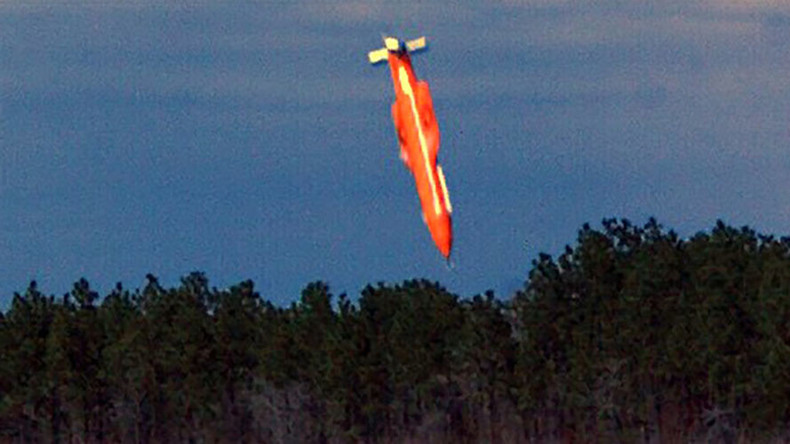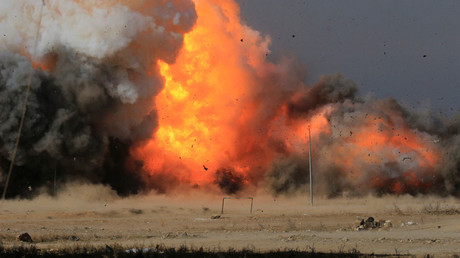https://www.rt.com/news/403554-iran-father-bomb-moab/
Iran claims to have ‘father of all bombs,’ overshadowing American ‘mother’
Published time: 16 Sep, 2017 14:09 Edited time: 18 Sep, 2017 10:31
Get short URL

FILE PHOTO: A GBU-43/B bomb, or Massive Ordnance Air Blast (MOAB) bomb © Global Look Press
The bomb was developed under a special request of the IRGC, the corps’ Aerospace Force commander, Brigadier General Amir Ali Hajizadeh, said in an interview on Friday.
READ MORE: US drops largest non-nuclear bomb on Afghanistan, first time used in combat
“Following a proposal by the Aerospace Force of the Islamic Revolution Guards Corps (IRGC), [Iran’s] Defense Industries [Organization] manufactured a 10-ton bomb. These bombs are at our disposal,” PressTV cited the commander as saying.
“They can be launched from Ilyushin aircraft and they are highly destructive,” he added, without providing any further details on the capabilities of the ordnance.
Read more
 Forget the ‘mother of all bombs,’ meet the Russian-made ‘daddy’
Forget the ‘mother of all bombs,’ meet the Russian-made ‘daddy’
The commander called the device the “father of all bombs,” comparing it to the US GBU-43/B Massive Ordnance Air Blast Bomb (MOAB), commonly known as the “mother of all bombs.” Since the American device weighs 9.8 tons and yields 11 tons in TNT equivalent, the IRGC commander presumably referred to the weight of the new Iranian ordnance rather than its destructive potential.
The MOAB was developed in 2003 and first used in combat this April, when the US dropped the device in Afghanistan on a mountain tunnel complex used by Islamic State (IS, formerly ISIS/ISIL) terrorists.
The new Iranian ordnance, however, might trigger a bomb paternity dispute, as Russia already possesses a non-nuclear ordnance known as the “daddy.”
The Aviation Thermobaric Bomb of Increased Power, known as the ‘father of all bombs’ (FOAB), was successfully tested by Russia in 2007, with impressive results for a non-nuclear device – a 44-ton yield when detonated. The bomb explodes midair, vaporizing its targets, collapsing structures, and leaving a moon-like scorched landscape.
Iran claims to have ‘father of all bombs,’ overshadowing American ‘mother’
Published time: 16 Sep, 2017 14:09 Edited time: 18 Sep, 2017 10:31
Get short URL

FILE PHOTO: A GBU-43/B bomb, or Massive Ordnance Air Blast (MOAB) bomb © Global Look Press
- 1
The bomb was developed under a special request of the IRGC, the corps’ Aerospace Force commander, Brigadier General Amir Ali Hajizadeh, said in an interview on Friday.
READ MORE: US drops largest non-nuclear bomb on Afghanistan, first time used in combat
“Following a proposal by the Aerospace Force of the Islamic Revolution Guards Corps (IRGC), [Iran’s] Defense Industries [Organization] manufactured a 10-ton bomb. These bombs are at our disposal,” PressTV cited the commander as saying.
“They can be launched from Ilyushin aircraft and they are highly destructive,” he added, without providing any further details on the capabilities of the ordnance.
Read more
 Forget the ‘mother of all bombs,’ meet the Russian-made ‘daddy’
Forget the ‘mother of all bombs,’ meet the Russian-made ‘daddy’ The commander called the device the “father of all bombs,” comparing it to the US GBU-43/B Massive Ordnance Air Blast Bomb (MOAB), commonly known as the “mother of all bombs.” Since the American device weighs 9.8 tons and yields 11 tons in TNT equivalent, the IRGC commander presumably referred to the weight of the new Iranian ordnance rather than its destructive potential.
The MOAB was developed in 2003 and first used in combat this April, when the US dropped the device in Afghanistan on a mountain tunnel complex used by Islamic State (IS, formerly ISIS/ISIL) terrorists.
The new Iranian ordnance, however, might trigger a bomb paternity dispute, as Russia already possesses a non-nuclear ordnance known as the “daddy.”
The Aviation Thermobaric Bomb of Increased Power, known as the ‘father of all bombs’ (FOAB), was successfully tested by Russia in 2007, with impressive results for a non-nuclear device – a 44-ton yield when detonated. The bomb explodes midair, vaporizing its targets, collapsing structures, and leaving a moon-like scorched landscape.
